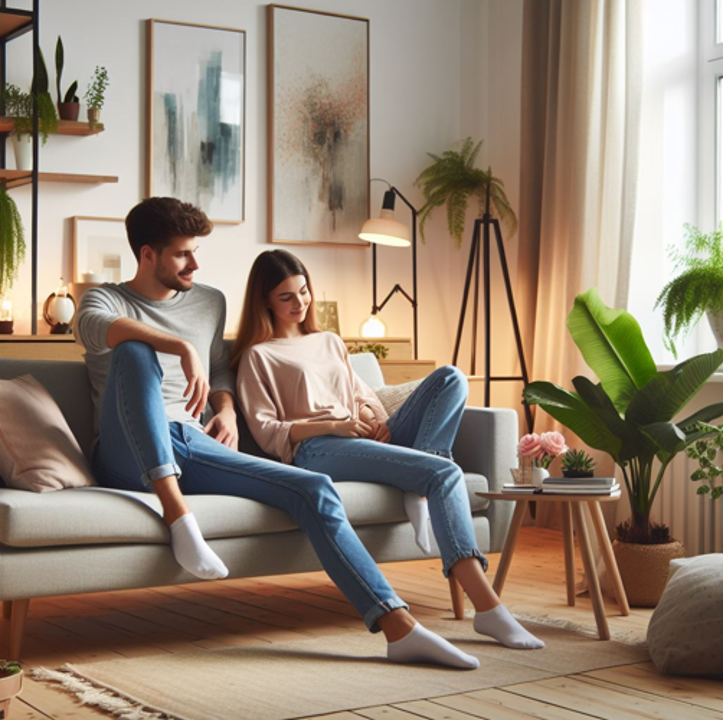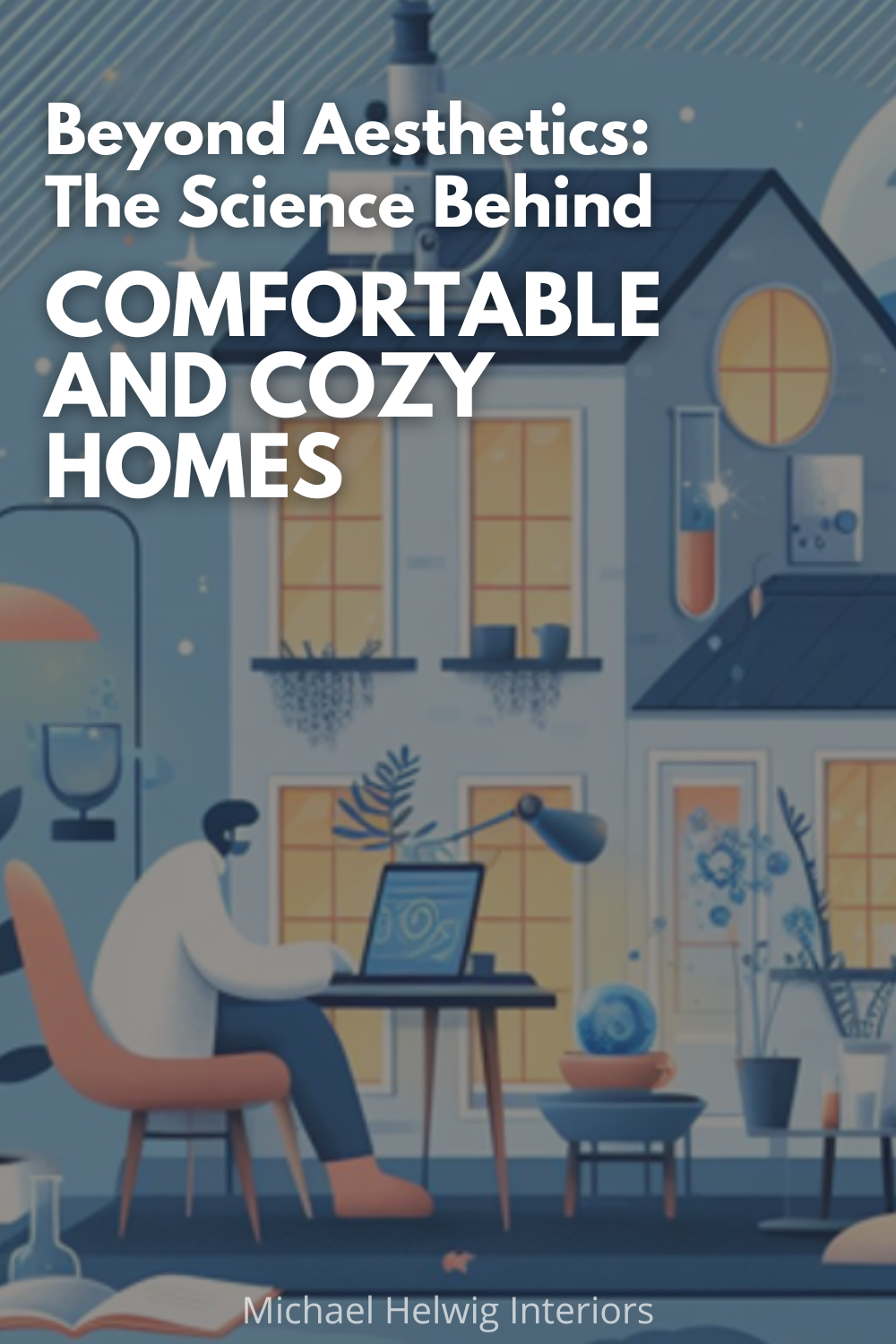Picture this: it's a chilly winter evening, and you've just arrived home after a long, exhausting day. As you step through the door, a wave of warmth comes over you, along with the familiar aroma of your favorite candle. You kick off your shoes, sink into the plush sofa, and wrap yourself in a cozy blanket. In that moment, you feel relief wash over you—that feeling of comfort and coziness that instantly melts away the stresses of your day.
Sound too good to be true? Well, what if I said that this scenario isn’t just a luxury but a necessity? That how you feel when you’ve made it home from tough days can and does affect ALL of you and how you show up for everybody else.
One of the things that nearly every client I work with asks of me is to help them create a “comfortable and cozy” home.
That got me thinking, what does comfortable and cozy really mean?
Is it just about curling up on the sofa with the fireplace going and your favorite show or a book? That’s a stereotypical image in my mind.
There must be more to it than just that, right?
Well, what I found out is that there is way more to it than cozying up on the sofa. There’s a lot of science behind it.
This one is all about why comfort and coziness are more than just aesthetic preferences—they're essential for your well-being.
From the impact on stress levels to how we connect with others, let’s talk about why your home absolutely needs to be comfortable and cozy and why that’s vital for your overall quality of life.
Understanding Comfort and Coziness
What do Comfort and Coziness Really Mean:
Comfort and coziness are often used interchangeably, but they affect distinct yet intertwined concepts when it comes to your home.
Comfort can be described as a state of physical ease and relaxation, while coziness adds an additional layer of emotional warmth and intimacy.
In this way, comfort can be thought of as the stuff you have, and coziness is more about the feelings you have about your stuff.
Together, they create a sense of refuge—resulting in spaces where we feel safe, content, and at peace.
Psychological and Emotional Aspects:
Feeling comfortable and cozy in your home goes beyond just physical comfort; both deeply influence your psychological and emotional well-being.
Research in psychology suggests that our surroundings can have a big impact on our mood and mental health.
A cozy environment can bring out our feelings of security, nostalgia, and belonging, supporting and reassuring us in times of stress or uncertainty.
All the Feels of Coziness:
Several things can contribute to your sense of coziness at home:
1. Temperature: Maintaining an optimal temperature is crucial for comfort. Whether it's the warmth of a crackling fireplace on a cold winter's night or the cool breeze of a ceiling fan on a sweltering summer day, temperature plays a significant role in creating a comfortable space.
2. Lighting: Lighting can dramatically affect the ambiance of a room. Soft, warm lighting can create a cozy, inviting feeling, while harsh, bright lights may feel sterile and unwelcoming. Candlelight, string lights, and dimmer switches offer other lighting options for creating specific effects.
3. Textures: The tactile experience of surfaces and materials can greatly influence your perception of comfort. Plush rugs, soft blankets, and upholstered furniture invite us to relax and unwind, while smooth surfaces add visual interest to their tactile counterparts.
4. Scents: Fragrance has a powerful effect on our mood and emotions. Pleasant scents like lavender, vanilla, and citrus can make you feel calm, while unpleasant odors can sink from the overall coziness of a space. Scented candles, essential oil diffusers, and fresh flowers are popular ways to infuse our homes with inviting aromas.
By paying attention to these sensory elements that trigger your feelings, you will begin to tune into ways to align your individual beliefs about your home’s comfort and cozy factors.
The Science Behind Comfort
Psychological and Physiological Benefits:
Feeling comfortable isn't just a matter of preference—it's essential for your psychological and physiological well-being.
When you're in a state of comfort, your body and mind are better able to relax and recuperate from the stresses of daily life.
Physiologically, comfort promotes lower heart rates, reduced muscle tension, and improved digestion.
Psychologically, it fosters a sense of safety and security, which is crucial for your mental health and overall sense of well-being.
Impact on Stress Levels, Mood, and Overall Well-being:
Research suggests that having a comfortable home can help reduce levels of cortisol—the stress hormone—in the body, leading to decreased feelings of anxiety and tension. And, feeling comfortable and at ease in your surroundings can elevate your mood, increase feelings of happiness and contentment, and enhance your ability to cope with challenges.
So, when you have higher levels of comfort in your home, you’ll also enjoy lower levels of psychological distress and higher overall life satisfaction. I’ll take that any day, wouldn’t you?
The Role of Biophilia:
One fascinating concept that sheds light on our need for comfort at home is biophilia—the innate human tendency to seek connections with nature and other living organisms.
According to biophilic design principles, incorporating elements of nature into your home can have profound benefits for your health and well-being.
These are things like
Maximizing natural light.
Having and caring for indoor plants.
Maximizing views of nature.
Studies have also shown that exposure to biophilic elements can reduce stress, improve cognitive function, and promote overall feelings of happiness and relaxation.
If you want to create environments that not only look beautiful but also support your physical and psychological health, think about adding in a few of these biophilic design elements.
Indoor Sauna: The Ultimate Comfort Factor
When looking to add an element of luxury and comfort to your home, an indoor sauna can be an excellent investment.
It offers lots health benefits, including stress relief, detoxification, and relaxation, Best of all, an indoor sauna could be a great way to add extra comfort to your home.
indoor saunas come in lots of beautiful options - ranging from pre-built ones to custom-designed models.
No matter which customization route you go, remember to choose one that suits your space aesthetics, budget, and lifestyle.
So, go ahead and introduce an indoor sauna and you’ll not only enhance your comfort and well-being but also add value to your property.
Importance of Comfortable and Cozy Homes
Why Home as a Sanctuary is Important:
Your home is more than just a physical space—it's your sanctuary and refuge from the outside world.
Life can be busy and hectic, right?
That’s why home should be the ideal place where you can retreat, recharge, and reconnect with yourself and your loved ones.
This is precisely why creating a comfortable and cozy home is essential for nurturing your physical, emotional, and mental well-being.
The Link Between Comfort at Home and Productivity, Creativity, and Relaxation:
In an article by Pennsylvania design firm, Heritage Design Inc. They explain how the comfort level of our homes directly impacts your productivity, creativity, and ability to relax.
When you feel comfortable and at ease in your surroundings, you're better able to focus your attention, think creatively, and tackle tasks with efficiency and enthusiasm.
On the other hand, discomfort and dissatisfaction with your home can hinder your ability to concentrate, stifle your creativity, and contribute to feelings of stress and anxiety.
When you feel good at home, your creative juices start flowing. That can have exponential benefits on your life and how you show up for everybody that depends on you.
How a Cozy Home can Improve Your Social Connections and Family Bonding:
Whether it's gathering around the dinner table for a home-cooked meal, snuggling up on the sofa for a movie night, or hosting a cozy get-together with loved ones, a comfortable and cozy home helps to create moments for joy, and connection.
Research has shown that strong social connections and family bonds are associated with lots of health benefits, including reduced risk of depression, improved immune function, and longer lives.
When you prioritize a comfortable and welcoming home, you will create spaces that nurture these important relationships and contribute to your overall happiness and well-being.
Feeling Off When Home Is Uncomfortable
Common Reasons for Feeling Unsettled or Uncomfortable:
There are some common reasons why you might feel unsettled or uncomfortable in your home. Here 4 common ones that you can change pretty easily:
1. Lack of Personalization: When your home doesn’t reflect your personal tastes and preferences, you may feel disconnected or out of place.
2. Poor Ergonomics: Uncomfortable furniture, awkward layouts, and inadequate lighting can all contribute to feelings of physical discomfort and unease.
3. Environmental Stressors: Excessive noise, harsh lighting, and poor air quality can create a hostile environment that undermines your sense of well-being.
4. Clutter and Disorganization: A cluttered and disorganized home can overwhelm your senses and contribute to feelings of anxiety and overwhelm.
How Clutter, Disorganization, and Environmental Stressors Affect Your Coziness and Comfort at Home:
Let’s unpack these reasons a little more. Clutter, disorganization, and other environmental stressors can have a profound effect on your comfort level and overall sense of well-being.
Clutter, in particular, has been linked to increased levels of cortisol—the stress hormone—in the body, as well as feelings of anxiety and depression. Disorganization can make it difficult to relax and unwind, leading to feelings of frustration and overwhelm.
If you add environmental stressors like noise pollution, poor lighting, and air pollution it can exacerbate your feelings of discomfort and unease.
What You can do NOW to Add a Level of Comfort and Coziness:
1. Declutter and Organize: Take time to declutter your home and establish systems for organization to create a more streamlined and harmonious environment.
2. Personalize Your Space: Add decor that reflects your personality and interests, like meaningful artwork, cherished mementos, and favorite colors.
3. Optimize Ergonomics: Invest in comfortable and ergonomic furniture, arrange your space to promote good posture and movement, and ensure adequate lighting to reduce eye strain and fatigue.
4. Minimize Environmental Stressors: Take steps to minimize environmental stressors in your home, like using noise-canceling headphones, incorporating natural light and greenery, and improving indoor air quality with plants or air purifiers.
By addressing these factors and creating a home that prioritizes comfort and coziness, you can create a home that supports your physical, emotional, and mental well-being.
Where to Focus on Creating Comfortable and Cozy Spaces
Practical Suggestions to “Up” Your Comfort and Coziness Factor:
Decorating different areas of your home can really impact your sense of well-being and contentment. Here are some practical tips for creating cozy spaces:
1. Bedroom: Invest in high-quality bedding and pillows for comfortable sleep. Add soft, plush rugs and curtains to create a warm and inviting space. Also, think about adding calming colors and textures to promote relaxation too.
2. Living Room: Arrange your furniture in a way that encourages conversation and social interaction. Use throw blankets and cushions to add warmth and comfort to seating areas. Incorporate soft lighting and candles to create a cozy ambiance.
3. Workspace: Choose ergonomic furniture and accessories to support comfort and productivity. Personalize your workspace with photos, plants, and meaningful objects to create a sense of belonging and inspiration. Incorporate natural light and greenery to promote a sense of calm and well-being.
Why Personalization Matters:
Personalization is more important than you might think. It actually plays a crucial role in creating a comfortable environment that reflects your unique tastes and preferences.
Adding things that resonate with you on a personal level will help you create a space that feels truly inviting and nurturing.
Bring in cherished heirlooms.
Display artwork that speaks to you.
Choose furnishings in your favorite colors and styles.
Embracing your individuality is key to creating a home that feels like a true sanctuary.
Your Design Choices and Details Matter:
Thoughtful furniture placement can maximize functionality and flow while creating intimate and inviting gathering spaces.
Lighting can be used to create ambiance and highlight focal points, while decor like rugs, curtains, and artwork adds warmth and personality to your room.
And, incorporating natural elements like wood, stone, and greenery can bridge the connection to the outdoors, enhancing the comfort and coziness of indoor spaces.
By paying attention to these design elements and integrating them harmoniously into your home, you can create spaces that are both comfortable and aesthetic, fostering a sense of well-being and contentment for you and your family.
Now take a moment to reflect on your own living spaces.
Are there areas of your home that could benefit from more comfort and coziness?
Are there changes you could make to enhance your well-being and create a more inviting environment?
Whether it's decluttering and organizing, incorporating personal touches, or adjusting your lighting and furniture arrangement, small changes can have a big impact on the comfort and coziness of your home.
Remember, your home is more than just a physical space—it's a reflection of who you are and a sanctuary where you can nourish your body, mind, and soul.
By prioritizing comfort and coziness in your home, you can create spaces that support and enhance your overall well-being, sense of happiness, contentment, and fulfillment for years to come.
Read Next:
Your Recipe For Designing A Beautiful And Functional Room: Pro Tips And Inspiration
Transform any room into a beautiful and functional space with these pro tips. Discover how to define the purpose of the room, consider the needs of the people using it, and plan the layout and functionality. Get additional tips on finding inspiration, choosing colors, mixing patterns, and creating a cohesive look.
Join the Fun!
If you enjoyed this post and you want to keep seeing my weekly blog, the best way to do that is to subscribe.
You can subscribe by downloading my 11 Secrets Only Designers Know to Make Your Space Rock. If you’re curious about how decorators and designers make a home look magazine ready, you’ll love taking a gander at these 11 secrets. You’ll learn how to style your room from the floor up and it will work for ANY space you have.
I write about small space design and decorating, sustainable furniture options, positive self care and a variety of do-it-yourself home décor.
I’d love to connect with you!
“Michael Helwig was top-notch, very professional and responsive to my needs. He allowed me time to explore ideas and try out a variety of combinations until we found the perfect fit. Michael provided detailed information and offered beautiful ideas to make my dream living room become a reality. The furniture he sourced has totally transformed my living room space. Everyone that has seen my new living room has one word, WOW! A special thank you to Michael for a wonderful experience.”
“Michael was very knowledgeable and guided us, with great patience and good humor, through the process of designing our dining room and helping us find the perfect sleeper sofa. He offered really helpful advice when we asked questions - which was often - but at no time did we ever feel pushed. He helped me when I felt like I couldn’t make one more decision. When my new furniture finally arrived I realized everything down to the pillows was perfect. I couldn’t be happier!”
Michael is Principal designer and blogger at Michael Helwig Interiors in beautiful Buffalo, New York. Since 2011, he’s a space planning expert, offering online interior e-design services for folks living in small homes, or for those with awkward and tricky layouts. He’s a frequent expert contributor to many National media publications and news outlets on topics related to decorating, interior design, diy projects, and more. Michael happily shares his experience to help folks avoid expensive mistakes and decorating disappointments. You can follow him on Pinterest, Instagram and Facebook @interiorsmh.




















